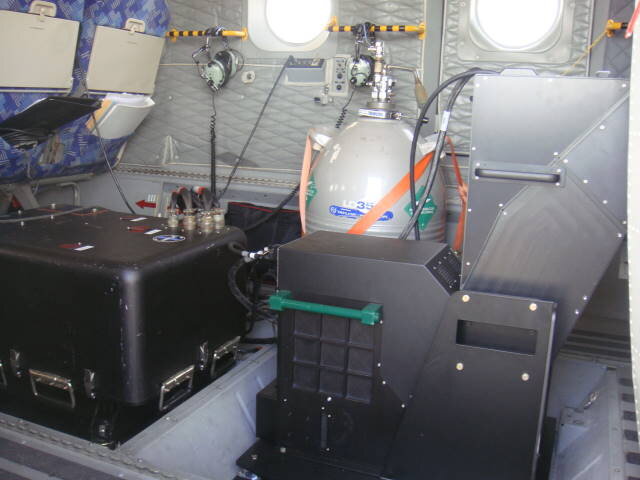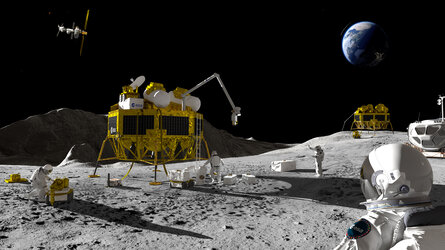ESA campaign reveals glimpse of future Sentinel-3 imagery
As part of the development process for ESA’s Sentinel-3 Earth observation mission, remote-sensing experts carried out an extensive experiment campaign across southern Europe this summer. The results provide valuable insight into the imagery the mission will deliver after it is launched in 2013.
For all new Earth observation missions, a crucial part of the development process, after defining and designing the instruments, is to assess the future performance of the sensors.
In addition, the algorithms being developed to transform the satellite data into usable information products also have to be tested.
In order to make these assessments, ESA organises test campaigns using airborne instruments that closely match the characteristics of the spaceborne sensors. The effort is coordinated with ground-based teams that collect complementary scientific data for calibration and evaluation.

One such campaign was recently completed for Sentinel-3, which is the third in a series of five space missions ESA is developing for the Global Monitoring for Environment and Security (GMES) initiative.
Led by the European Commission, GMES will fulfil the growing need among European policy-makers to access accurate and timely information services to manage the environment, understand and mitigate the effects of climate change, and ensure civil security.
The ‘Sentinel-3 Experiment’ campaign – or Sen3Exp for short – involved a series of coordinated activities with scientists making ground-based measurements in Spain, Italy and the Ligurian and Adriatic Seas, while aircraft with sensitive instrumentation passed overhead and satellites acquired data simultaneously from space.
The result is a comprehensive dataset of imagery and ground-truth information that can be used to simulate Sentinel-3 optical data, test the processors under development to generate the data products, and analyse whether these data products will satisfy the requirements of the user communities.
The campaign's Principal Investigator, Dr Carsten Brockmann, confirmed that, “A unique, comprehensive and valuable dataset has been created that will significantly support the development of the Sentinel-3 mission.”
Primarily, Sentinel-3 will support services related to the marine environment, such as maritime safety services that need ocean surface-wave information, ocean-current forecasting services that need surface-temperature information, and sea-water quality and pollution monitoring services that require advanced ocean colour products from both the open ocean and coastal areas. Sentinel-3 will also serve numerous land, atmospheric and cryospheric application areas such as land-use change monitoring, forest cover mapping and fire detection.

The mission's complement of optical sensors will comprise an Ocean Land Colour Instrument (OLCI), which is based on Envisat’s Medium Resolution Imaging Spectrometer (MERIS), and a Sea Land Surface Temperature Radiometer (SLSTR), which is a successor to Envisat’s Advanced Along Track Scanning Radiometer (AATSR).
The Sen3Exp campaign began in June in Barrax, La Mancha, Spain. An aircraft operated by the Spanish National Institute for Aerospace Technology (INTA), equipped with three hyperspectral imaging spectrometers, made two flights over the area. Meanwhile, satellite data were acquired by Envisat’s MERIS and AATSR and by the Compact High Resolution Imaging Spectrometer (CHRIS) aboard ESA’s Proba-1 satellite. At the same time, ground teams, under the direction of Prof. Jose Moreno from the University of Valencia, made atmospheric radiometric and biophysical measurements.

The campaign then moved to Pisa in Italy, from where a pine forest at San Rossore could be reached. At San Rossore, Prof. Federico Magnani from the University of Bologna oversaw the week-long ground measurement programme. The dataset was again complemented with MERIS, AATSR and CHRIS satellite data.
In July, activities focused on the marine environment where measurements were taken at two oceanic sites: the Boussole monitoring buoy in the Ligurian Sea and the Aqua Alta Oceanographic Tower (AAOT) in the Adriatic Sea, close to Venice. Both sites have played an important role in supporting ocean colour algorithm development and product validation for many years.

Boussole typifies the global ocean, where the measured signal is determined solely by the absorption of phytoplankton. AAOT is in an area where there is both open ocean water and also water that is optically complex because phytoplankton, suspended sediments and coloured dissolved organic matter also affect the measured signal. Such water can be found in all coastal regions and is a challenge to understand from space.
Routine radiometry measurements are made at these locations, both above and below the water surface and fed into the Mermaid database, managed by ARGANS, UK. A unique flight pattern was developed by the Sen3Exp team that encompassed a wide range of observational configurations. Two overpasses over each site were carried out and an image over the coast that included the transition between land and ocean was also acquired, which will be important for understanding how the signal behaves in coastal zones.

The campaign also took advantage of the fact that the MERIS 15 spectral bands can be reprogrammed. Thus, for several short periods during the campaign window, data were acquired using some of the new spectral bands planned for OLCI and provided some of the most realistic simulations possible of the data expected from Sentinel-3.
With more than 60 people involved, the success of this technically and logistically complex campaign demonstrates the excellent cooperation between European scientists. Now comes the task of analysing the huge dataset collected during the campaign. An additional opportunity for data analysis is provided by the inclusion in of data collected from the Airborne Prism Experiment (APEX) imaging spectrometer during a parallel campaign in Switzerland and Belgium.
In the meantime, Professors Moreno and Magnani agree that, “A large data archive has been generated that will help not only to provide important input for Sentinel-3 but will be valuable for future ESA missions.”















 Germany
Germany
 Austria
Austria
 Belgium
Belgium
 Denmark
Denmark
 Spain
Spain
 Estonia
Estonia
 Finland
Finland
 France
France
 Greece
Greece
 Hungary
Hungary
 Ireland
Ireland
 Italy
Italy
 Luxembourg
Luxembourg
 Norway
Norway
 The Netherlands
The Netherlands
 Poland
Poland
 Portugal
Portugal
 Czechia
Czechia
 Romania
Romania
 United Kingdom
United Kingdom
 Slovenia
Slovenia
 Sweden
Sweden
 Switzerland
Switzerland































